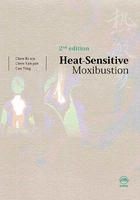
8 Relationship between HSM Sensations and Therapeutic Effect
Obtaining the arrival of qi is vitally important in ensuring moxibustion is effective.Eliciting moxibustion sensations is the same eliciting the arrival of channel qi in acupuncture. Both are a sign that the channel qi has been stimulated and moved,show the innate regulatory systems of the body have been activated, and foretell a positive therapeutic effect.
The essence of acupuncture is expressed in The Spiritual Pivot – The Nine Needles and Twelve Sources, “The arrival of qi ensures the therapeutic effect. This effect is reliable, like the wind blowing away the clouds to see the heavens. This is the complete path of needling.”[23] This chapter describes the importance of activating channel qi and causing it to transmit to the affected body part. Ancient doctors realized the need to activate channel qi in obtaining positive therapeutic effects. In Records of the Three Kingdoms, there is a description of how Hua Tuo used acupuncture to cure disease: “When inserting the needle, he would tell the patient where he expected the sensation to reach.If this occurred, the patient said, “It has arrived.” He then withdrew the needle and the patient recovered.”[24] This vividly describes the relationship between the transmission of the channel qi and the therapeutic effect. It says in The Great Compendium of Acupuncture and Moxibustion, “To cure a disease far [from the spot being needled], the channel qi must be induced to reach the affected part.”[25]
Over the past four decades, research by scholars in China has shown that the transmission of the channel qi shows that qi is moving, and is a mark of the body’s innate regulatory functions being activated. The therapeutic effect of acupuncture is closely related to the degree of channel qi transmission. The greater the degree, the better the effect. Activating channel qi and causing it to reach the affected part of the body can sometimes lead to unexpected results in difficult diseases.
The sensations of HSM are induced when suspended moxibustion is administered on acupoints, and include penetrating heat, expanding heat, transmitting heat, distal but not local heat, deep but not surface heat, and non-heat sensations. Like the transmission of channel qi induced by acupuncture, the HSM sensations are signs that the channel qi has been moved, and show that the innate regulatory functions have been activated.
We recently conducted comparison studies on the therapeutic effect of moxibustion.One group received HSM moxibustion based on heat sensitization, and the other received traditional moxibustion based on pattern differentiation. The diseases treated included myofascial pain, knee osteoarthritis and prolapsed lumbar intervertebral disc. The results showed that the eliciting of HSM sensations greatly enhanced the therapeutic effect of suspended moxibustion. In myofascial pain, for example, the percentage of cases that experienced an obvious therapeutic effect in the HSM group was 86%, compared to 24%in the group receiving traditional moxibustion. In knee osteoarthritis, the percentage was 80.95% in the HSM group and 21.05% in the traditional moxibustion group. Prolapsed lumbar intervertebral discs showed an 82% effective rate with HSM, compared to 41%with traditional moxibustion.